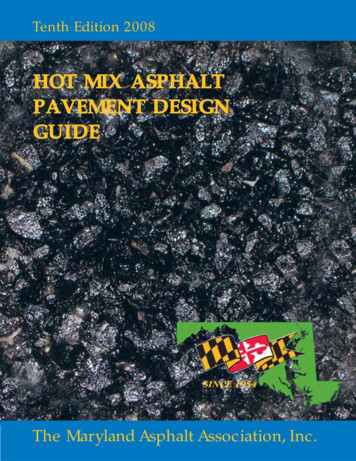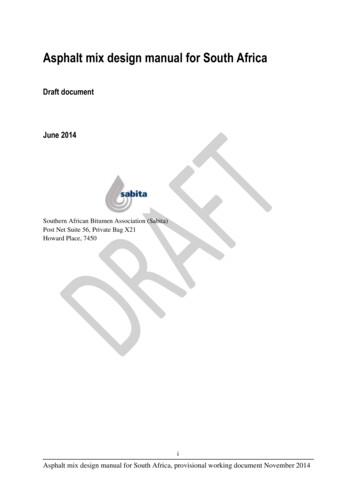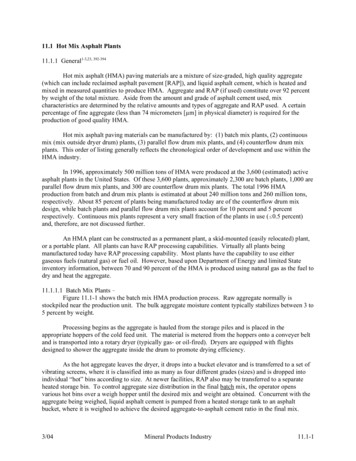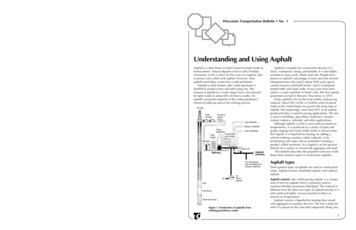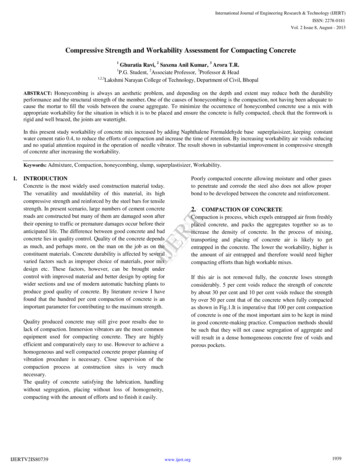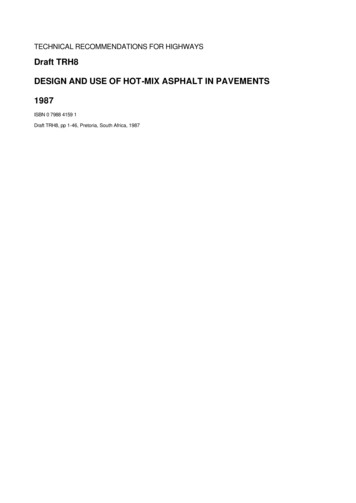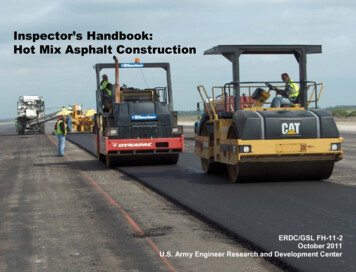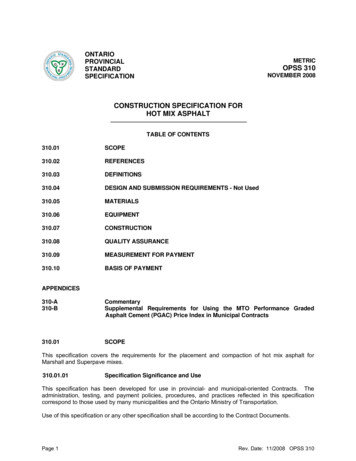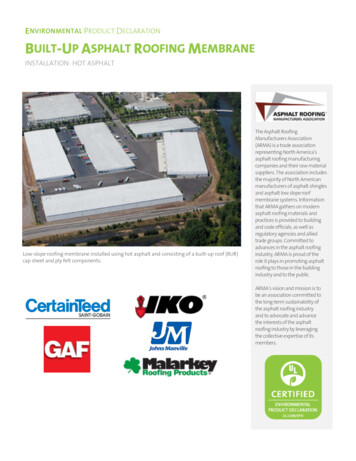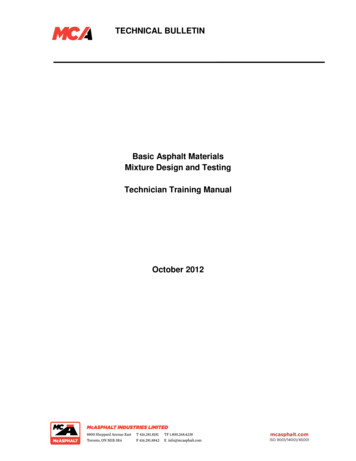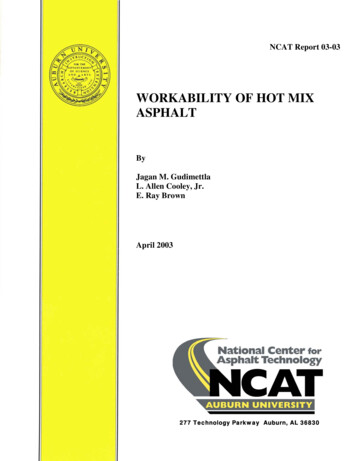
Transcription
NCAT Report 03-03WORKABILITY OF HOT MIXASPHALTByJagan M. GudimettlaL. Allen Cooley, Jr.E. Ray BrownMike HunerApril 2003277 Technology Parkway Auburn, AL 36830
WORKABILITY OF HOT MIX ASPHALTBy:Jagan M. GudimettlaGraduate StudentNational Center for Asphalt TechnologyAuburn University, Auburn, AlabamaL. Allen Cooley, Jr.Manager, Southeastern Superpave CenterNational Center for Asphalt TechnologyAuburn University, Auburn, AlabamaE. Ray BrownDirectorNational Center for Asphalt TechnologyAuburn University, Auburn, AlabamaNCAT Report 03-03April 2003
DISCLAIMERThe contents of this report reflect the views of the authors who are responsible forthe facts and accuracy of the data presented herein. The contents do not necessarilyreflect the official views or policies of the National Center for Asphalt Technology orAuburn University. This report does not constitute a standard, specification, orregulation.-i-
TABLE OF CONTENTSIntroduction.1Objective .2Scope .2Background and Problem Statement.2Literature Review on Measuring Workability .2Need for Measuring Workability of HMA .4Determining Mixing and Compaction Temperatures .6Research Approach .9Task 1 – Development of the Prototype Workability Device.11Task 2 – Identify Limitations of Prototype Workability Device .13Task 3 – Effect of Equipment Variables on Workability .13Task 4 – Evaluation of Material Effects .14Task 5 – Evaluate Method of Determining Compaction Temperature of HMA .14Task 6 – Prepare Final Report .16Material Properties.16Aggregates .16Gradations .16Binder Properties .16Mix Designs .23Test Results and Analysis .23Data Reduction.23Task 2 – Identify Limitations of Prototype Workability Device .26Effect of Equipment Variables on Workability .29Limestone Mixtures .30SMA Mixtures .30Rounded Aggregates.30Calibrating the Device .32Effect of Mix Constituents on Workability .32Effect of Aggregate Type.35Effect of NMAS.40Effect of Binder Type .41Effect of Temperature .42Summary of Workability Testing .42Concept of Using Mix Workability to Define Compaction Temperature ofHMA Mixes .43Compacting Temperature Methodology .45Shear Study .45Conclusions and Recommendations .50References .52Appendix A – Raw Workability Data from Task 4 .54- ii -
ABSTRACTThe term workability has been used to describe several properties related to theconstruction of hot mix asphalt (HMA). Workability in the field can be defined as aproperty that describes the ease with which a HMA can be placed, worked by hand, andcompacted. This definition provides a term that is applicable to movement of HMAthrough equipment to the roadway, handwork of HMA, and compactibility on theroadway.Due to the performance benefits of polymer-modified binders, their use hasincreased in the US. However, with the use of polymer-modified binders, the workabilityof HMA decreases substantially at a given temperature since the modifiers tend toincrease the viscosity of binders. Compacting HMA with polymer-modified binders canbe more difficult with modified binders than for mixes that utilize unmodified binders. Ifthe compositional properties of a mix, such as aggregate physical properties andgradation are kept constant, workability of HMA is basically a function of binderproperties at a given temperature. The higher the temperature the better is the mixworkability since the viscosity of the binder decreases as temperature increases.However, increasing the mix temperature to obtain a desired workability is not alwaysbest. Problems that result from excessive temperature include: 1) damage to asphalt (heathardening); 2) damage to additives; 3) increased fuel consumption; and 4) increasedsmoke and volatile organic compounds (VOC) production.The primary objective of this study was to develop a device to measure theworkability of HMA mixes that could identify the change in workability due to changesin mix characteristics. Secondly, this study was to evaluate a method in which mixworkability could be used for establishing approximate compaction temperatures forHMA mixes.Based on the findings of this study a device was successfully designed to measurethe laboratory workability of HMA mixes. The device immerses a paddle into a sampleof HMA. The torque required to keep the paddle rotating at a constant speed within thesample is then measured. Workability was defined as the inverse of the torque required torotate the paddle within the sample of HMA. The workability of HMA was affected byaggregate type, and, thus, aggregate properties. Mixes prepared with a cubical, angulargranite were less workable (generated more torque at a given temperature) than mixesprepared with a semi-angular crushed gravel. The workability of HMA was affected bythe nominal maximum aggregate size (NMAS) of the gradation. As NMAS increased fora given aggregate type, gradation shape, and binder type, workability decreased.Gradation shape did not have a significant effect on workability. However, there werenumerous two- and three-way interactions that were significant that included gradationshape. Binder type significantly affected the workability of mixes. Mixes modified tomeet a PG 76-22 were significantly less workable than mixes containing an unmodifiedPG 64-22. There was a relationship between workability and temperature that showedincreased workability at higher temperatures. A preliminary attempt was made at utilizingworkability data to determine a realistic compaction temperature of HMA mixes.However, this was a limited effort and the results were inconclusive.- iii -
Gudimettla, Cooley Jr., & BrownWORKABILITY OF HOT MIX ASPHALTJagan M. Gudimettla, L. Allen Cooley, Jr., and E. Ray BrownINTRODUCTIONThe term workability has been used to describe several properties related to the construction ofhot mix asphalt (HMA). First, some have used this term to describe the ease with which HMAcan be worked by hand after being placed on the roadway. Others have also used the termworkability to describe the compactibility of HMA. In combination, workability can be definedas a property that describes the ease with which a HMA can be placed, worked by hand, andcompacted. This definition provides a term that is applicable to movement of HMA throughconstruction equipment to the roadway, handwork of HMA, and compactibility on the roadway.Satisfactory workability is important in obtaining the desired HMA smoothness and densitywithin a compacted pavement. For mixtures that are very harsh, therefore having lowworkability, it can be more difficult to construct smooth pavements. Pavements that are undercompacted may experience significant performance problems primarily due to high voids (1). Ifnot properly compacted, the potential for permeability problems, as well as rate of oxidativeaging of the binder, is increased considerably thereby reducing the life of the pavement.Due to the performance attributes of polymer-modified binders, their use has increased in theUS. However, with the use of polymer-modified binders, the workability of HMA decreasessubstantially at a given temperature since the modifiers tend to increase the viscosity of binders.Therefore, compacting HMA to achieve the desired density can be more difficult with modifiedbinders than for mixes that utilize unmodified binders. If the compositional properties of a mix,such as aggregate physical properties and gradation are kept constant, workability of HMA isbasically a function of binder properties at a given temperature. The higher the temperature thebetter is the mix workability since the viscosity of the binder decreases as temperature increases.However, increasing the mix temperature to obtain a desired workability is not always best.Problems that result from excessive temperature include: 1) damage to asphalt (heat hardening);2) damage to additives; 3) increased fuel consumption; and 4) increased smoke and volatileorganic compounds (VOC) production (2, 3).Traditionally, binder viscosity has been used to determine mixing and compaction temperaturesof HMA. Compaction temperatures obtained with this method directly affect the workability ofthe mix since equi-viscous binder conditions are used. But with the increasing use of modifiersand new HMA mix types (e.g., Superpave and stone matrix asphalt), problems with selectingsatisfactory mixing and compaction temperature have been observed. Therefore, a study wasneeded to assess methods of evaluating the workability of HMA mixtures and the use ofworkability to establish mixing and compaction temperatures needs to be evaluated.1
Gudimettla, Cooley Jr., & BrownObjectiveThe primary objective of this study was to develop a device to measure the workability of HMAmixes that can identify the change in workability due to changes in mix characteristics.Secondly, this study was to evaluate a method in which mix workability could be used forestablishing approximate compaction temperatures for HMA mixes.ScopeA literature review was conducted to identify developments in measuring the workability ofHMA and other materials. This information was used to develop a device to measure theworkability of HMA mixes. Initial tests with the fabricated device included testing of mixeshaving different expected ranges of workability to evaluate any equipment limitations so thatnecessary modifications could be made. Once modifications were made, further testing wasconducted to optimize the equipment configuration. After the equipment configuration wasfinalized, mixes with different combinations of binders, aggregates, gradation shape and nominalmaximum aggregate size (NMAS) were evaluated with the device. This data was then analyzedto determine the effect of individual mix constituents on the workability of HMA. Workabilitydata of mixes with the same combinations of gradation, aggregate properties, and nominalmaximum aggregate size, but with different binders, were also evaluated to potentially propose apreliminary method for establishing the compaction temperature for HMA mixes. A Superpavegyratory compactor (SGC) equipped to measure the gyratory shear was used to evaluate thispreliminary method of establishing compaction temperature.BACKGROUND AND PROBLEM STATEMENTWithin this section, a review of literature on methods of measuring the workability of HMA isprovided. Also included within this section is a discussion on why the measurement of HMAworkability is important. Most specifically, the effect of polymer modified versus unmodifiedbinders is discussed. Finally, current methods of determining the mixing and compactiontemperatures for HMA are discussed.Literature Review on Measuring WorkabilityAn attempt at measuring the workability of HMA was presented at AAPT in 1978 by Marvilletand Bougault (4). According to the paper, workability of HMA is dependent on the compositionof the mixture, such as binder grade, amount of binder, and aggregate properties (type, gradation,etc). The authors also found workability dependent on external parameters such as the design ofthe equipment and temperature.Marvillet and Bougault described an instrument that can measure the workability of HMA. Theinstrument (Figure 1) consisted of a chamber that is attached to a rigid frame. A motor, mountedon top of the frame, rotates a single blade within the mix at a constant rotational speed. The totalweight of the mix used by the authors was approximately 15 kilograms. A spring, along with apotentiomer, was attached to the rigid frame of the machine and was used to measure the2
Gudimettla, Cooley Jr., & Brownresistance of mix within the chamber against the rotation of the blade. The electrical signal wasconverted to numeric values and expressed in units of torque.Figure 1. Diagram of the Workability Meter (4)A CORECI regulator was used for measuring and displaying the temperature of the mix. Theentire chamber where the mix was placed was heated to raise the temperature of the mix at therate of 1 C/min. Test results were recorded as the temperature increased from 150 C to 200 C.The blade used to push the mix rotated at a constant rotational speed of 22 RPM. In Marvilletand Bougalt’s paper, the term “Workability” was defined as the inverse of the resistance moment(torque) produced by the mix against the rotation of the blade. Therefore, as torque increased,workability decreased.Results from Marvillet and Bougalt s study (4) can be summarized as follows: Workability of HMA mixtures increased as the viscosity of the binder grade decreased. Change in binder content did not have any direct relationship with workability. As the filler content in the mix increased, the workability decreased. Mixes with angular particles were less workable than mixes having semi-angular or roundaggregate particles.A number of devices have been used to measure the workability of Portland cement concrete.One device is the two-point workability device (5). In the Two-point workability device thetorque required to rotate an impeller at a constant speed while submerged in the concrete ismeasured. The impeller, or paddle, is rotated at various speeds and the corresponding values oftorque are noted. The Two-point workability machine is illustrated in the Figure 2.3
Gudimettla, Cooley Jr., & BrownFigure 2. Two-Point Workability Machine (5)Need for Measuring Workability of HMAModification of asphalt binders has increased within the last few years. Modifiers have increasedthe resistance of HMA pavements to some major distresses such as deformation (rutting),cracking (thermal and fatigue) and disintegration (raveling and stripping). Several laboratorystudies, as well as field experience, have shown the effectiveness of using modified binders inHMA. According to Terrel and Epps (3), some of the reasons for modification are: Reduced1. Structural thickness of pavement layers.2. Life cycle cost of pavement.3. Low temperature cracking of pavements.4
Gudimettla, Cooley Jr., & Brown 1.2.3.4.5.6.ImprovedFatigue resistance of asphalts.Bonding between aggregate and asphalt and thus reduce stripping.Resistance to aging or oxidation.Crack sealing.Overall performance of pavements.Strength and stability of mixes.The different types of additives commonly used as HMA modifiers based on genericclassifications, according to Terrel and Epps, are shown in Table 1. Each type of modifier shownin the table has a specific use. For example mineral fillers, extenders, rubbers, plastics, fibers,oxidants and hydrocarbons are often helpful in increasing the stiffness of the pavement at highertemperatures and reducing stiffness at lower temperatures (3). Modifiers like lime can be used toimprove the adhesion between asphalt and aggregate in the presence of water, thereby, reducingthe stripping potential in HMA. Some mineral fillers, antioxidants and hydrocarbons canimprove the binder’s long-term durability.Table1. Generic Classification of Binder Modifiers (3)TypeExamplesFillerMineral filler, Carbon Black, SulphurExtenderSulphur, LigninPolymersRubber, PlasticFiberNatural, Man madeOxidantManganese SaltAntioxidantCarbon, Calcium SaltsHydrocarbonRecycling and Rejuvenating oilsAntistripAmines and LimeAlong with the advantages associated with modified binders there are problems as well, most ofwhich are construction-related. These include identification of appropriate mixing andcompaction temperatures, pumpability of the modified binders, and short and long-term aging ofHMA. A paper published in the Association of Asphalt Paving Technologists (AAPT) titled“Classification of Asphalt Binders into Simple and Complex Binders” (6) reported the results ofa survey describing problems encountered with the viscosity-temperature method fordetermining mixing and compaction temperatures for modified binders. The most frequentproblem being that mixing and compaction temperatures obtained by the traditional temperature-5
Gudimettla, Cooley Jr., & Brownviscosity method for modified asphalt binders were much higher than those for unmodifiedbinders.The problems associated with high compaction temperatures are many. As noted, asphalt bindersare mixed with modifiers to achieve specific qualities. When modified binders are heated to hightemperatures separation may take place between the modifier and base asphalt (7). If thishappens the effectiveness of the modified binder will be reduced. There are several otherproblems as well, some of which include: Excessive heating may result in oxidation of the binder, and damage which may result inpremature pavement cracking. Both visible (smoke) and non-visible emissions increase as the binder’s temperature isincreased. This may pose health and environmental problems. Due to separation, modifiers may be extruded from the mix onto the pavement surfaceunder breakdown rolling. This will cause excessive pick-up of material when usingrubber tire rollers, which may cause unacceptable surface texture. Heating the HMA mix to a high temperature can also release the internal moisture of theaggregates. The moisture can then cause the binder to be semi-emulsified during thevibratory rolling process, which may lead to tenderness. Also excessive compaction temperatures can mean excessive mixing temperature. Thismay cause draindown of the binder in haul trucks for mixes like SMA (Stone MatrixAsphalt) and OGFC (open-graded friction courses) that use high asphalt contents.During the 1990s, there were some major advances in the design of HMA mixes. Mix designsystems for Superpave and Stone Matrix Asphalt (SMA) were adopted in the U.S. Both of thesedesign systems have proven to reduce the amount of rutting on the nation's highways (8).However, with these new mix design systems came a wider range in gradations than used in thepast. Historically, gradations associated with both the Marshall and Hveem mix design systemspassed close to or above the maximum density line. Gradations within the Superpave system areallowed to pass either above or below the maximum density line. SMA mixes are very coarseand generally contain 70 to 80 percent coarse aggregate (retained on 4.75 mm sieve). It would beexpected that mixes containing the same aggregate and binder type, but having differentgradations will likely have different workabilities.Determining Mixing and Compaction TemperaturesThe equi-viscous temperature range of asphalt has long been used in establishing the mixing andcompaction temperatures for mix designs and field production. This procedure assumes that twomixes with the same aggregate gradation exhibit similar volumetric properties when mixed withsoft or hard binder as long as they are mixed when the asphalt viscosity is similar.The Asphalt Institute presented the first recommendation for the laboratory mixing andcompaction temperature ranges based on viscosity of asphalt in 1962 within its publication “MixDesign Methods for Asphalt Concrete and Other Hot-mix Types” (9). According to this methodthe temperature to which asphalt must be heated to produce viscosities of 85 10 secondsSaybolt-Furol and 140 15 seconds Saybolt-Furol should be taken as mixing and compactiontemperature, respectively. Saybolt-Furol viscosity is the viscosity of a liquid measured based on6
Gudimettla, Cooley Jr., & Brownthe time taken for a specific amount of liquid to flow through an orifice of specified dimensions.In 1974, the Asphalt Institute changed the viscosity measurements from units of Saybolt-Furol tounits of centistokes (cSt) (10). In this procedure absolute viscosity, in poise, at 60 C andkinematic viscosity at 135 C in cSt are measured. The absolute viscosity at 60 C is thenconverted into kinematic viscosity (cSt) by dividing viscosity by the specific gravity of thebinder at 60 C. The two kinematic viscosity points are then plotted on a viscosity andtemperature graph with viscosity on a log-log centistokes scale and temperature in log Rankine.The two points are joined as a straight line. Once the line is established, viscosity ranges of170 20 cSt were recommended for mixing temperature and 280 30 cSt for compactiontemperature, while performing the Marshall mix design.With Superpave, the basic concept of equi-viscous mixing and compaction remained the same.However, the units of measuring viscosity changed from cSt to Pascal-seconds (Pa-s) and theviscosity values are now determined using a Rotational Viscometer at 135 C and 165 C. Oncethe two points on a semi-log graph are known the temperature-viscosity relationship isestablished. After this line is established on the graph the viscosity range of 0.17 0.02 Pa-s isused for mixing temperature and 0.28 .03 Pa-s is used for compaction temperatures duringSuperpave mix design (Figure 3).As can be seen from all the procedures described above, the basic principles remain that bothmixing and compaction temperatures should be taken as the temperature at which the binderachieves a specific viscosity. Using this concept, polymer-modified binders require much highertemperatures to attain the same viscosity as unmodified binders. Temperatures obtained formixing and compaction by the existing methods can be 177 C or higher. This is not reasonablebased on experience.Recently, Yildrim et al. (11), put forth a new method for determination of mixing andcompaction temperature. According to this paper the traditional method of using viscosity andtemperature to determine the mixing and compaction temperature is suited for unmodified binderbut not for modified binders. The authors indicate that unmodified binders are basicallyNewtonian in nature; that is their viscosity is not shear rate dependent. Modified binders atcertain temperatures tend to exhibit a property called shear thinning, or pseudo-plasticity, whereviscosity depends on shear rate. They suggested that shear rate inside the rotational viscometerdoes not simulate the shear rates inside a gyratory compactor during compaction. The paperconcludes that the shear rate inside the Superpave gyratory compactor should be calculated firstand then points on the temperature-viscosity graph should be obtained by measuring theviscosity at those shear rates. Once the two points are obtained the paper says that the viscositytemperature graph can be used to determine the mixing and compaction temperatures.De Sombre et al. (12) also provide an idea on the compaction temperature range for HMA. Theauthor considered the asphalt mix to behave similar to a soil, and used Mohrs-Columb equationto explain the shear stress in the HMA mix:7
Gudimettla, Cooley Jr., & BrownFigure 3. Typical Viscosity –Temperature Plot to Determine CompactionTemperatureτ c σ tan øWhere,τ shear stress in the mixc cohesion of the mixσ normal stress in mixø angle of internal frictionAccording to the De Sombre et al., shear strength for HMA is dependent on both the binder aswell as the aggregate properties. The asphalt binder provides the cohesive component in HMAand the friction is provided by the aggregate particles. At a given temperature and normal stress,the cohesion of the mix depends on the amount of the binder, nature or degree of modification ofthe binder, and the filler used. As the amount of binder increases it becomes easier to work, (i.e.,compact the mix). But as the degree of modification or filler content increases the cohesion ofthe mix increases which makes it more difficult to compact. With regard to aggregates, the morerounded the aggregates the lower the angle of internal friction, which reduces the shear strengthof the mix. In this study six different lab samples and five different field mixes were compactedin a Finnish gyratory compactor. This compactor measured the shear stress and power requiredto compact each sample to 4% air voids. Samples were compacted at different temperatures. The8
Gudimettla, Cooley Jr., & Brownrelationships between shear and temperature necessary to compact were examined. According tothis study an examination of the field temperature data combined with laboratory compactiondata showed that for most mixes there was a minimum shear stress, which indicated that anoptimum compaction temperature range existed (Figure 4).Figure 4. Relation Between Stress and Compaction Results for the Field MixesTested (14)The following are observations from development of this background information: Workability of HMA depends on binder type, gradation, aggregate type, additives andtemperature of the mix.There has been a limited attempt at quantifying the workability of HMA in the literature;however there are some limitations with this prototype.Instruments have been designed to measure workability based on the principle of usingthe torque necessary to rotate a paddle within a mix.The traditional method of using viscosity-temperature relationship to determine mixingand compaction temperature was developed for neat binders. It does not take into accountthe mix properties like aggregate properties and/or gradation shape while determining themixing and compacting temperatures.There is an increasing need to determine the mixing and compacting temperatures forHMA mixes especially when modified binders are used.RESEARCH APPROACHTo accomplish the project objectives, six separate tasks were conducted. The first task entaileddevelopment of the prototype workability device. Within the second task, mixes of expecteddifferent workability characteristics were tested with the prototype device to evaluate thelimitations of the equipment and to identify needed refinements. Task 3 entailed varying several9
Gudimettla, Cooley Jr., & Brownequipment characteristics to select a combination of equipment variables and to develop atentative standard testing procedure. Next, after the equipment and test procedure were selected,samples were tested to determine the effect of material constituents on workability. Task 5entailed a limited study to evaluate the potential of using workability results to determinecompaction temperature of HMA mixes. The final task entailed preparing a final reportdocumenting the conduct of this study. Figure 5 illustrates the overall research approach.BeginTASK 1 - Develop PrototypeEquipment5 mixes of varyingstiffnessTASK 2 - Identify Limitations ofModified EquipmentMake Refinements, if needed3 mixes of varyingstiffnessTASK 3 - Evaluate Equipment EffectsRate of RevolutionShaft ConfigurationPaddle ConfigurationSelect Best Equipment ConfigurationFull FactorialTASK 4 - Evaluate Material EffectsTASK 5 - Evaluate Method ofDetermining CompactionTemperatureGradationAggregate TypeAsphalt Binder TypeNom. Max. Agg . S
The term workability has been used to describe several properties related to the construction of hot mix asphalt (HMA). First, some have used this term to describe the ease with which HMA can be worked by hand after being placed on the roadway. Others have also used the term workability to describe the compactibility of HMA.

